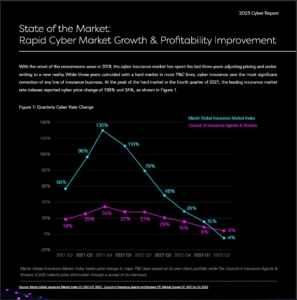Higher Exposures and Shrinking Risk Appetite
Edited December 22nd, 2023 by Kyle Langan
Exposure Growth and Global Reinsurance Capital: 2022 Results
After Hurricane Ian, traditional and alternative capital declined by around 20-25% at 2022’s close, compared to 2021’s close. [1] After adjusting for the interest rate impact of mark-to-market losses on fixed income securities, Swiss Re estimated a “decline in capital of around 5%. [2] However, exposures – proxied by GDP – continue to rise fast. [3] This has created a gap between supply and demand.” [4] Exposure refers to the “state of being subject to loss because of some hazard or contingency.” [5]
With these conditions, what is the impact on the insurance market?
“Higher exposures and shrinking risk appetite typically result in rising prices, higher retentions and tighter terms and conditions.” [6] The prospect of still-elevated catastrophe losses and constrained capacity come as geopolitical, economic and environmental uncertainties remain omnipresent.” [7] Analysts may downgrade financial ratings, like Scottsdale Insurance Company, which A.M. Best lowered to ‘A’ on December 7, 2023. [8]
Tail risk from infectious diseases should remain a risk management priority; a lurking systemic cyber event with destructive potential is another tail exposure to monitor. [9]
Capital (GAAP Reporting)
2021 = 116.3
2022 = 96.6
Decrease = 17%
Capital (Solvency Reporting)
2021 = 113
2022 = 108.1
Decrease = 4.3%
Exposure (~GDP)
2021 = 112.2
2022 = 122.1
Increase = 8.8%
Source: AM Best, Swiss Re Institute
References
[1-4]; [6-7] Continued high losses from natural catastrophes in 2022: Swiss re. Continued high losses from natural catastrophes in 2022 | Swiss Re. (2023, November 14). https://www.swissre.com/institute/research/sigma-research/sigma-2023-01/5-charts-losses-natural-catastrophes.html
[5] Exposure. IRMI. (n.d.). https://www.irmi.com/term/insurance-definitions/exposure#:~:text=Exposure%20refers%20to%20the%20state,of%20some%20hazard%20or%20contingency.
[8] Scottsdale Insurance Company – Ratings.ambest.com. (2023, December). https://ratings.ambest.com/disclosurepdf.aspx?ambnum=3292
[9] Cirillo, P., & Taleb, N. N. (2020, May 25). Tail risk of contagious diseases. Nature News. https://www.nature.com/articles/s41567-020-0921-x


